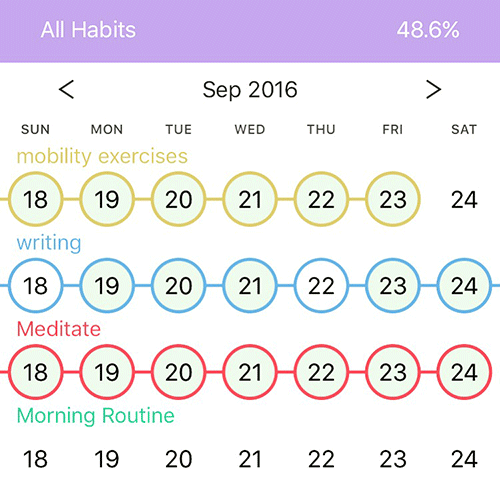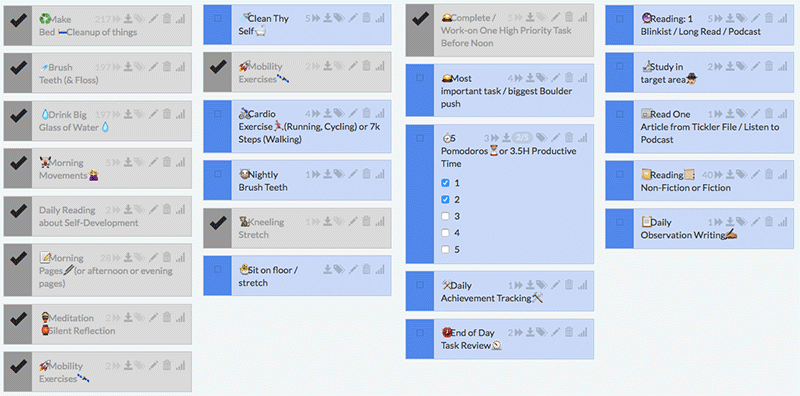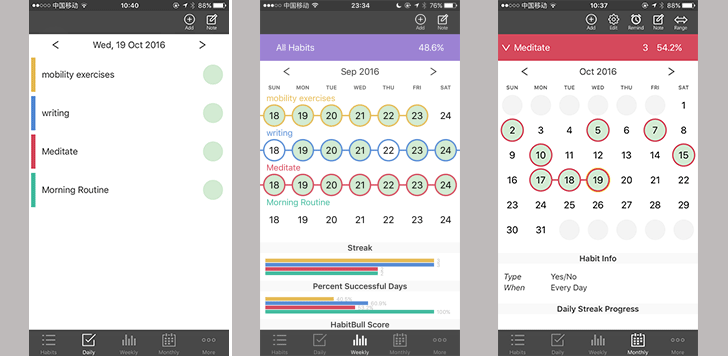![]()
We are a product of our habits–personal and organizational. Coming to grips with our habits and tendencies can have a huge impact on your life.
There are two areas that I believe all self-trackers need to incorporate in order to effectively track a life: habit tracking and life logging.
Habit tracking is about “check-ins” on your behavioral changes, while life logging is about recording all (or part) of the miscellaneous things you do in a day, i.e. how many times you smile or how often you poop.
When done consciously and meaningfully, habit tracking and life logging provide a wealth of information about the self. But when it comes to habits, it has the added bonus of helping you improve yourself. To effectively track a habit is to build and reinforce a (positive) behavioral change.
In this post we are going to look at habit tracking. We will look briefly at the difference between habit tracking and life logging. We will examine some great tools to track your habits. Finally we will talk about the larger implications of habit tracking and personal development.
Habit Tracking vs. Life Logging: What are They?
Habit tracking is the act of recording your habits using any number of devices and techniques. On a practical level you are logging that you completed some regular activity.
Behaviorally habit tracking goes deeper in that it is part of a trigger-feedback-improvement cycle. Your end goal is a self-improvement but the process itself is part of a self-development method including the act of tracking a habit. So, if self-tracking is more than just recording, more than just the data collection, then habit tracking is more too; it’s about building up a self of habits.
Life Logging is a slightly different beast. The term itself is mixed with some of the more extreme elements of the quantified self movement, namely video life loggers who record every moment of their lives in streaming video. While there are some interesting lessons to be learned through these stream of consciousness forms of life logging, I’m more interested in life logging in the sense of tally tracking various elements of your life.
Life logging is a kind of organized “tally” tracking. It is the act of recording different elements of your life from how many coffees and glasses of water to how many times you said “Thank You” or complained. Like tracking your habits, life logging has the potential to lead to behavioral changes, but unlike developing a habit, life logging requires a longer period of maturation.
You first record some aspect of your life, like how often you pee, before attempting to understand an area and derive lessons from your behaviors. With life logging you tally it, before you attempt to correlate it with something meaningful. Sometimes the meaning comes in trying to visualize that area.
Unlike other forms of self-tracking, life logging and habit tracking require a much higher level of dedication and discipline. While tools might help you track your steps and time with little input from the tracking person, life logging and habit tracking are not passive at all; they are active choices you take to record parts of your lives. You might go so far as to say that the act you take in tracking is part of the behavioral change or at least behavioral noticing.
Fortunately there are a number of tools that make it “easy” to try either life logging or habit tracking. For life logging my to favorite tools are Logsit and Nomie. (In past I’ve also used AskMeEvery for life logging.) Both effectively let you “check in” any random thing you want to track. Both these tools can work for habit tracking, though typically the best tools for habit tracking have a more clearer focus.
Habit Tracking: Tools for Recording and Building Better Behaviors

I have a number of tools I use to be “Productively Awesome”. Some of my favorites are Evernote for capturing any and all text, Todoist for wrangling my task list and projects, and RedMine for Team Project Management.
When it comes to habit tracking, I’ve tried and used a lot of tools over the years. My current favorites are Habitica and HabitBull. There are a number of habit trackers I’ve tried and liked like Strides and Habit List which are both available on iOS.
All of the habit trackers do the following: They allow you to list a number of activities you wish to track and then a simple way to record that you did that activity. So you might list “meditate” and then each day you check it off.
From there, different tools might include daily reminders or provide calendars and statistics to show your progress.
The biggest difference between Habitica and HabitBull is social gamification vs. personal analytics.
Habitica: Social Gamification for Habit Tracking
Habitica is a Habit Tracker App, which “Treats Your Goals Like a Role Playing Game” and, to extent, to effectively use Habitica you are going to need a party of fellow players to use it. Habitica’s UI is basic but robust and allows you to handle a lot of different activities from Habits to Dailies to Tasks. It’s available on all major platforms (Web, iOS & Android).
I’ve been using Habitica for some time and here are the main dailies I track: Morning Routine, Work Habits, Study Habits, and Health & Wellness Habits.

The end result of completing all of these daily habits and tasks is my own avatar (circa October 2016):
![]()
The analytics and visualizations on habits for Habitica are not very strong though there is some basic elements there to look into. Habitica’s strength lies in your personified self or avatar. By completing your habits and tasks you gain points that allow you to equip and design your character. You can use gold to get weapons and spells as well as you use items you collect to hatch and raise pets.
The main social gamification element comes from Quests which you do with your party. By completing your activities in the real world, you contribute to fighting different monsters. If you fail to complete your tasks, you not only hurt your avatar but also those of your quest mates.
As a tool, I think Habitica provides a good piece of software to log your habits and tasks. It’s main failing (at present) is its weak data model. You have access to an export of your dailies history, but there are several issues. First, your dailies are not properly timestamped to allow you to understand how you log habits in relation to other elements for your day. So, the data you get back is timestamped to a cron process for calculating score and damage.
Second, the data model also does log “completion status” and instead you must use an aggregation score to interpret different results, so it’s difficult to know exactly if you completed a task or not.
Finally, the visualization around building a new habit is subtle via different color changes, though I’d prefer a much stronger perspective of streaks and completed habits over time. Each daily should have a dedicated page showing how you are doing, your history and progress, if you want to use it effectively to build a habit.
Overall, Habitica is the best tool available for social gamification of habit tracking and habit building. Its stickiness makes it hard to abandon your group and, in turn, abandon the habits you are working on.
(Personally, I’m working on trying to improve at least the timestamps around Habitica Dailies to make it a better tool for self trackers. See Issue #870 on GitHub)
HabitBull: Refined Analytics and Visualized Progress Habit Tracker
HabitBull is a personal habit tracker, and it fits squarely in that category. It’s a crowded space with a lot of apps to track your habits like Momentum or Strides. I also like Habit List. These apps don’t aim to incorporate social or gamification. Instead, they are tools for easily tracking your habits and, in turn, providing statistics and visuals for understanding how you are building up a habit.

I believe HabitBull is one of the best tools if you are a quantified self tracker looking for a great all-around habit tracker. There are multiple ways to check-in your habits via a daily or weekly format. It’s visually clear where you stand.
HabitBull provides a great export of the data, so if you want to add it to an aggregator like Zenbase to create an overall look at your data in habits and tasks. The weekly, daily and monthly views make it quick and easy to see if you did your habits. And finally it has an aggregated percentage and score for getting to regular completion of that habit.
While Habitica is my primary logger of habits, it’s not as focused or analytical for when I start new habits or working on areas that I’m having trouble sticking to. That’s where a dedicated tool like HabitBull fits in. I focus on 3-5 habits. These are my “cornerstone” habits and, if I’m able to get them accomplished, typically my day, productivity, energy level and overall contentment soars.
Moreover, HabitBull provides a clear export of my data that makes it easy to mashup accordingly.
Conclusion: Why All Self-Trackers Should Track their Habits
It is often argued that the goal of building any new habit is to try and reach 21-days of unbroken activity. The theory goes that if you can make it to 30 or 21 days straight you have built a new habit. If you can check-in that habit for such a streak, you have formed a new habit. As such, habit tracking might only be useful during this initial habit creation period.
As a long-time habit builder, I’m not so sure. Habits rarely just fall into your life after a month, especially with habits that take a certain level of effort like meditation or running. I’ve seen waves of engagement and disengagement with certain habits.
That’s where it’s good to add a habit tracker. On the surface, habit trackers are tools to help you log if you did a certain thing. But deeper down you are developing life routines where not doing a habit and not checking it in feels “off.” Once you have a regular activity that you somehow failed to do and you can’t help but be reminded to do it, then you know you have a habit.
For a quantified self-er, habit trackers allow you to get real data on an important area of your life, namely your habits. Whether it’s flossing and brushing your teeth, daily reading or regular exercise, habit trackers provides you with the data to know if and when you did those key activities.
In turn, having a record of that data makes it possible to look at the fuller picture of your life. Using data multiple sources from your tasks (with Todoist) and habits (with HabitBull) and from your time (with RescueTime and Toggl), you can create a complete picture of your day. From the time you spent to the work and studies you did, these data points let you have a very accurate look at your day.
While much of this data is still in separate areas, there are an increasing number of aggregators that are mashing them together. Gyroscope is a particularly great example of this as it looks at movements (both steps and location) and combines it with productivity and time along with heart rate, photos and more to create amazing one slide visualizations of a day, week or month in your life.
While habits might seem like a minor area for a self-tracker, in my opinion it’s the central piece. Without reliably building and recording your habits, it’s impossible to build up a stream of data about your life events. By recording habits and by making a habit of recording and tracking in general, you enter into the pantheon of self-awarenessness through personal data.
Happy tracking!
